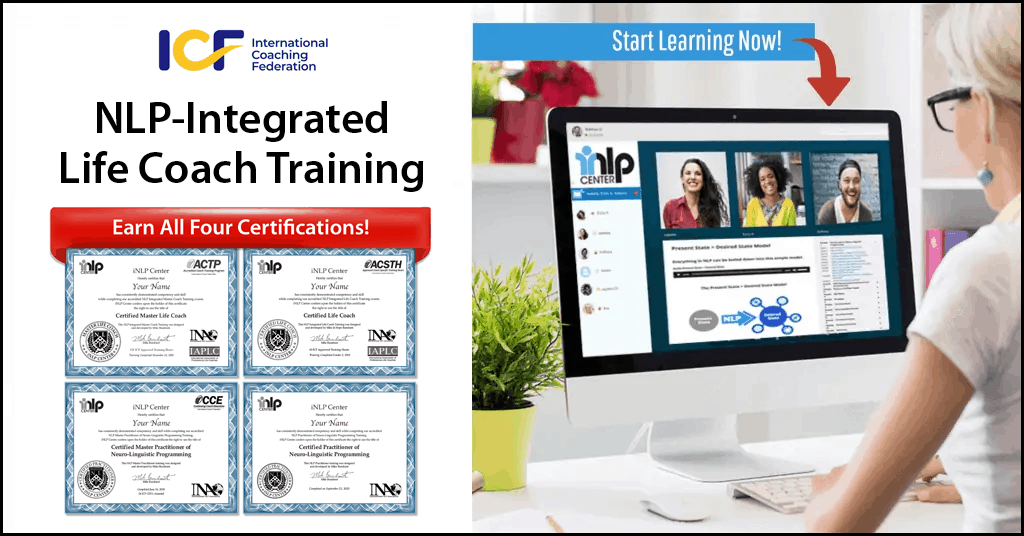Want to learn how to become a life coach? This is a step-by-step tutorial for anyone considering a career in coaching. We wrote this to make a practical difference between success and failure.
If you are serious about becoming a professional life coach because you enjoy helping people, you will be encouraged by what you read here. We’ve outlined the process very clearly to help you safely and sanely make the transition into your new coaching business.
If you’re ready to dive in, let’s go!
Step 1: Get Certified
The first step to becoming a life coach is to enroll in a reputable life coach certification program.
There are three styles of life coach training available:
In-Person Training
In-person coaching offers a structured, immersive learning environment. You get direct feedback and enjoy face-to-face interactions with your trainers.
But, this format comes with significant downsides. It’s more expensive, often requires commuting, and lacks flexibility in pacing and scheduling. It doesn’t readily support individual learning speeds or long-term community building.
Nonetheless, it remains a great option for those seeking a hands-on and intensive educational experience.
Unsupervised Online Courses
You can find lots of life coaching courses on Udemy and other similar online learning marketplaces. Though this may seem convenient and affordable, it is not how to become a life coach.
These courses do not offer any oversight or personalized feedback. You’re on your own, watching pre-recorded content. There’s no way for you or anyone else to know whether you are assimilating the skills taught.
Also, the International Coaching Federation does not recognize this kind of training. So you will not qualify for an ICF coaching credential if you choose this route.
Blended Learning (online with live classes)
Blended learning programs offer the best of both worlds. They combine on-demand lessons with live classes. So you get the flexibility, convenience, and affordability of online courses. Plus, the personalized supervision needed for proper learning and accreditation.
This type of program can be as rigorous as in-person training. It can also be approved by the International Coach Federation.
Interview each training center to see if it fits your needs. Check whether the International Coaching Federation accredits their programs. And choose a training that fits your lifestyle, philosophy, and wallet.

Step 2: Choose a Niche
After you become a certified coach, your next step is to choose an area to focus on. Specializing will help you stand out and attract people to your business.
When someone looks for a coach, they usually have a specific problem they want to address. And they’re more likely to choose a coach who’s good at solving that problem.
If someone’s having trouble in their marriage, they will look for a relationship coach. If someone’s stuck in their job, they’ll likely choose a career coach over a general life coach.
There are lots of coaching specialties to choose from. Here are some of the more popular ones:
- Relationship Coaching
- Career Coaching
- Mental Health Coaching
- Executive Coaching
- Life Purpose Coaching
- Weight Loss Coaching
You may want to consider narrowing down your focus area even more by focusing on a specific problem, set of problems, or audience.
As a life purpose coach, you could specialize in helping empty-nesters find new purpose.
As a mindset coach, you might focus on helping athletes regain confidence after serious injuries.
Here’s a template for writing down your niche:
“I help [common audience characteristics] who struggle with [specific problem] to [desired result].”
Example: “I help [solopreneurs] who struggle with [self-doubt] to [stay on track, gain confidence, and speed up their momentum].”
A clear niche helps you find and market to your ideal clients online and offline. Your niche will dictate which social media platforms to be on, what events to attend, and what blogs, podcasts, and local businesses to partner with.
Step 3: Get Practical Experience
This step is where you start applying what you’ve learned. It’s a chance to refine your coaching techniques, craft your coaching style, and learn how to work with different clients and goals.
How do you get experience when you don’t have clients yet?
Here are two of the most common ways to accumulate coaching hours:
Reciprocal Coaching: Team up with another coach or coach student and coach each other. It’s a straightforward way to practice. You coach them one week, they coach you the next. Coaching Buddies is a great program where we pair students with a practice partner by filling out our signup form.
Pro Bono Coaching: Offer your services for free to individuals or organizations such as the Coach Forward Foundation. This approach lets you test your skills in real-life situations and help others at the same time. You could put out an announcement for free coaching on social media or tell your social circle. It’s almost certain some of your connections would be curious to experience what working with a life coach is like.
Step 4: Set Up Your Coaching Business
Here’s a list of business and administrative tasks that you will need to complete while you set up your own life coaching business:
- Register your business
- Set up a website
- Get liability insurance
- Set up and populate social media accounts
- Create free introductory material
- Set up your email list
- Set up your online scheduler (ie. Calendly or SavvyCal)
- Design and print business cards, flyers, and printed marketing material
- Open a business bank account and set up basic accounting
- Prepare client contracts
If you’re thinking: “I can knock it all out in a week,” you may not understand how long these types of tasks take.
One of the programs we developed at the iNLP Center, the AHA Solution, took one full calendar year to develop from concept to end product. This is not shared to discourage you. It’s been well worth the time and effort. It brings in a steady stream of new student enrollments and coaching clients.
So start as soon as you can. And remember, the fancier you get with your branding and material, the more time the process will take.

Step 5: Build Packages
Life coaching isn’t like going to the doctor or hiring a plumber; we all know when we need to make a dentist’s appointment or call an electrician. But most people don’t know when to seek out life coaching.
That’s why a critical step in your sales and marketing plan is to create custom coaching packages that offer solutions to the specific problems your ideal clients are struggling with.
Packages increase the worth of each customer you attract to your business. They also help you build predictable revenue streams. A client who buys a coaching package commits for a given period (usually 3+ months).
On the other hand, a client buying single coaching sessions can leave you after only a few sessions. Without packages, you’ll have to look for new customers more often.
Not only that, but the client buying a package is more likely to experience positive results. Packages offer them a clear, organized path to reach their goals. Plus, the client receives guidance tailored to their specific needs.
You may offer different coaching packages to your clients, each one designed to solve a specific problem. As a confidence coach, for example, you could have one package for public speaking. You could have another package for dating and a third for job interviews.
If you work with single moms, you could offer one package for time management. Another for emotional resilience, and another for career development.
How long should a coaching package be? Long enough for you to be able to deliver the results the client is after. If you’re not sure where to start, start with a 3 month-package and adjust later if need be.
Related: Coach Package Creation Program
Step 6: Get clients
The next step is to get your name out there and get clients.
There are many creative ways you, as a certified coach, can market your new life coaching business. We’ve listed several below.
Your ideal customer should dictate what marketing channels you use. There’s not much point in using Instagram if the age of your niche clients is 50+.
Marketing can quickly get overwhelming, so stick to two or three and work to master them.
Social Media
An effective and low-cost way to promote your services. Create free accounts on Facebook, LinkedIn, Instagram, Pinterest, and other platforms. Choose the most fitting platforms, and be consistent in your messaging and posting schedule. Use apps like Hootsuite or Buffer to schedule posts in bulk.
Newsletter
Focus on building a mailing list early on. This is critical for expanding your reach. The main advantage of email is that you own your audience. It’s different with social media. Say you’ve built up an audience of 50,000 on Instagram. If tomorrow, Meta decides to ban your account tomorrow, you’re left with nothing. You can build your email list through lead magnets, events, and social media. Mailchimp and Substack are two software to create and send modern newsletters.
Online Ads
Digital ads require a budget. But they can give your brand exposure much faster than any other method on here.
There are two primary types of ads you can run:
- Search engine ads (eg. Google Ads or Bing Ads). These platforms are pay-per-click – meaning you’ll only pay when someone clicks one of your ads.
- Social media ads (eg. Facebook, Pinterest, Linkedin, etc). These platforms are pay-per-impression – meaning you’ll pay when someone sees your ads.
Once you set up your ad and it gets approved, it’ll start gathering eyeballs right away. But results aren’t guaranteed. It takes trial, error, and money to find what creatives and audience targeting to get people to buy from you.
Guest Blogging
As a starting coach, you most likely don’t have an audience to sell your products too. And you know building one will take time. In the meantime, you can partner with people who already have the attention of people you want to coach. Write articles for sites in related fields (not competitors) to drum up traffic to your website and increase awareness of your brand.
In-Person Networking
Join professional organizations like the local chapter of BNI, your local Chamber of Commerce, or the Business Improvement Association. This will help you build a local coaching business. Remember to carry business cards.
Word of Mouth
Tell your friends, former colleagues, and family members about what you do. Rather than talking about “life coaching”, tell them about the problem that you solve. Your college roommate may not know anyone who’s looking for a life coach. But they might know someone desperate to lose weight or level up their career.
Remember, marketing is about experimentation and iteration. If you invest time and money in a marketing channel and clients don’t come, learn to ask ‘why’.
- Are you addressing the wrong demographic?
- Is your value proposition clear?
- Have you made it easy for people to take action?
- Is your content bland or unhelpful?
Once you have a theory about what the issue might be, change your approach and see if you can tip the scales in your favor. Then start again.

Step 7: Keep learning and improving
The journey to becoming a life coach doesn’t end with certification or your first clients. Continuous learning and improvement are key to staying relevant and effective.
Here are some suggestions to keep growing and enhance your impact:
- Revisit your training to refresh your knowledge and sharpen your skills.
- Network with other coaches. Share your experiences to get new insights and collaborative opportunities. This can be online or at a local ICF meetup.
- Learn new skills. Consider adding hypnosis, neuro-linguistic programming, or group coaching to your skill set. You’ll become more effective in sessions and appeal to a broader client base.
- Attend workshops, seminars, and conferences. This will help you build a network within the coaching community. You’ll also hear about emerging trends in the industry before they go mainstream.
Frequently Asked Questions (FAQ)
A life coach helps people to get unstuck and move forward in their life. A life coach helps their clients get past obstacles to achieve their goals, thus becoming happier and more content with life.
Yes, anyone can be a life coach. But, to be a great life coach, you must develop the skills necessary to effectively work with clients such as active listening, powerful questioning, and the ability to decipher nonverbal communication.
The average salary for a life coach in the United States is USD 125 per hour. It may be more or less depending on your coaching niche, experience, and how well you market your life coaching business.
You do not need a degree to be a life coach because there are currently no regulations around the profession. However, we do not recommend anyone goes into business without first undergoing a reputable, accredited training. A coaching certification will help you be more effective with clients, but also be more credible and valuable in the market.
A life coach certification costs between $1000 and upwards of $15,000 depending on the training center, their accreditation and the type of training they offer. Don’t let the price fool you: a higher price does not always mean better training.
An average life coach training takes six month to one year to complete. Part of becoming a life coach is learning coaching skills and practicing coaching with others.
Ready to Become a Life Coach? Test Your Aptitudes
How do you know you’re a fit for life coaching? Perhaps people have often come to you for advice. Maybe you have a desire to help others get past the obstacles you have worked so hard to overcome.
Conclusion
Learning how to become a life coach involves more than just coaching skills. It involves a range of other business and practical skills and requires you to learn and follow a business model that other successful coaches are using.
It may seem like a lot of work, perhaps more than you were anticipating, but it does require time and patience to see results. It’s all about taking one step at a time and finding the right training program to support you.
Unfortunately, most coach training centers won’t teach you practical coaching skills and how to run a life coaching business. And, most training centers don’t support your learning and marketing after your course is complete.
We do! At iNLP Center, we do all of the above. When you join us, we’re here to help you with every step along the way.



